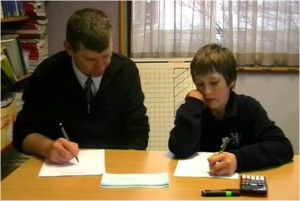How can I use the resources in the algebra framework?
Practical Instructions were developed from the experiences of the research team using the components of the algebra framework in high school classrooms with students. The practical instructions are written in a step-by-step way to help teachers who are new to using the algebra framework.
We suggest teachers follow the practical instructions carefully so that the test results can be discussed meaningfully with other teachers who are also using the algebra framework. By engaging in discussions with other teachers, we noticed that we were better able to select appropriate ways to help our students learn the challenging ideas about algebra.
Getting Started
A great place to start for teacher new to the algebra framework is with a whole class written test using the Solving Equations Diagnostic Test. This starting combination is powerful because it gives teachers a quick overview of how their students understand unknowns in the context of solving equations. The instructions for administering the Solving Equations Diagnostic Test are included with the printer-ready versions of the diagnostic tests listed in the Diagnostic Test section of this website.
After teachers have scored, and interpreted set of written responses from their students, they will a good sense of how their students understand the ideas presented in the diagnostic tests. Teachers will be able to use this information to inform their lesson planning. Teachers may wish to have more specific information about why a particular response was offered by a number of students or why a particular student responded they way he or she did. At this point, we encourage teachers to conduct One-on-one Diagnostic Interviews with students, which are described in the Going Deeper section below.
Going Deeper
For teachers interested in understanding more about how students are thinking about algebra, we recommend teachers conduct a One-on-one Diagnostic Interview with a student. The interview gives teachers the experience of hearing and seeing the levels of mastery of basic facts and algebraic notation directly from their students. Teachers should repeat the process with up to six students so they can get a sense of the range of understanding demonstrated by their students. Please note that the One-on-one Diagnostic Interview uses questions that are similar but not identical to the Solving Equations Diagnostic Test. The test questions are different so that you can administer both tests to the same students so they will not be repeating the test.
Eric’s experiences conducting one-on-one diagnostic interview with his students.
Even though it may seem like an unnecessary step, teachers on our research team found that conducting several one-on-one diagnostic interviews with students was an excellent investment of their time. Teachers also noticed that the diagnostic interviews revealed information about student understanding of algebra that was not evident to them on the written test alone. The diagnostic interview uses prompts such as “How did you work that out?”, “Explain your thinking.” and “How do you know that?” Such questions allow teachers to focus on the experience of one student engaging with a diagnostic test at a time. This ‘one-on-one’ experience allows teachers to hear and see what the strategies and knowledge topics students find challenging to learn in language that the student uses.
After conducting about six One-on-one Diagnostic Interviews, teachers will have a good understanding of how of the components of the algebra framework work together. We recommend that teachers use the other diagnostic tests with their students and use the results to inform their lesson planning. The other three diagnostic tests are shorter that the Solving Equations Diagnostic Test and the administration instructions are included with the printer-ready versions of the diagnostic tests listed in the Diagnostic Test section of this website.
- Rachel shares what she has learned from conducting diagnostic interviews with her students


